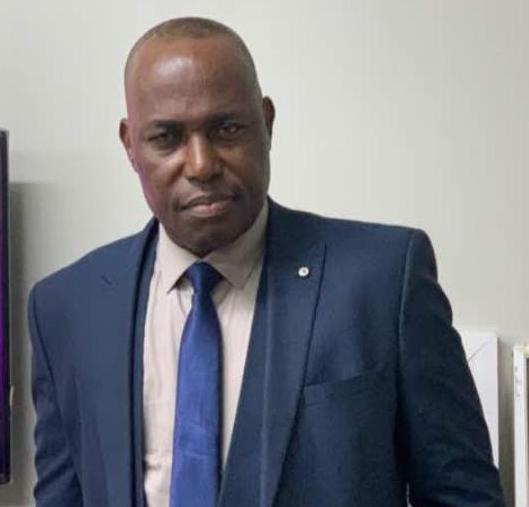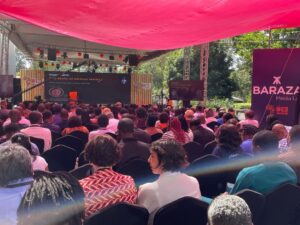Keynote by Martins Oloja, Editor-in-Chief, The Guardian, at the Nigerian Academy of Science 2021Media Award Dinner at Sheraton Hotel and Towers, Ikeja, Lagos on Friday, June 18, 2021.
I would like to thank the Nigerian Academy of Science (NAS) for the invitation to deliver this keynote on science journalism at this time. I have been asked to speak on ‘Evidence-based Science Communication in the COVID-19 Era’. To simplify the topic, I have modified it to read: ‘Science Journalism in Covid-19 Era’. In other words, the synopsis makes it so as ‘evidence-based communication’ in this context is summarised as ‘science journalism’. In other words, science is evidence-based just as journalism is (evidence-based). So, we do not need to write the qualifier, evidence-based before even non-scientists can understand science to be so. So it is with journalism as a social science subject. It is evidence-based. That is why we proclaim or even boast regularly that facts are sacred, only comment is free. That is to say that for journalism to maintain its integrity, it must continue to show pieces of evidence at all times. It is that evidence that builds brand reputation. In today’s world, journalism has evolved into all sorts of the genre as social technologies have shaped it. Haven’t you seen the ‘citizen journalism’ classification within the social media construct? This evolution has made journalism an enjoyable conversation as everyone is now involved in reporting and editing. However, the most critical construct now is Data and Investigative Journalism, which is again more evidence-based. This reporting style shows the power of data, which makes journalistic products and legworks of journalists measurable by readers, viewers, listeners and managers. The essence of this argument here is that today’s journalism will benefit immensely from the basis of science journalism, which you are celebrating today. I mean, there is today a convergence – of quantity and quality. Academics call their methodology qualitative and quantitative analyses. Good journalism that matters today can only showcase quality through its quantitative analysis capability. This is the essence of Data and Investigative Journalism framework that most journalism schools and institutes (including World Bank’s) have established. We managers have come to realize that stories with measurable elements have become more significant to business leaders, managers, policymakers, political leaders and even journalism teachers.
Here is the thing, investigative journalism, which has helped bring down governments, imprison politicians, trigger legislation, reveal miscarriages of justice and shame corporations has been so impactful because that brand of journalism is evidence-based. In other words, the investigative journalism that brought down President Richard Nixon of the United States in 1974 couldn’t have been just reports of nebulous sources. The legwork began with ‘how much was paid to tap the telephone of the Democratic Party’s office in Watergate Hotel in Washington. The two journalists who uncovered the scandal were Metro and Police reporters who began their investigation with financial journalism, which normally follows the money trail. So it was with the $8 million dollars worth of journalistic investigation that brought down Joseph Estrada in the Philippines in 2000. The legwork that tumbled the president lasted for eight months. The World Bank Institute has tagged that, ‘Journalistic Legwork that Tumbled a President’ ‘A case study and guide for investigative journalists.
That piece of journalism by the Philippine Centre for Investigative Journalism, which exposed the unexplained wealth of Joseph Estrada who was elected president in 1998 and until January 2001, was based on evidence gathered against the powerful president. That is the power of evidence, which only scientific or forensic elements can establish. And so, there is power in evidence, which is quite expensive to gather, in any case. The essence of this preface here is that only science journalism, (that is evidence-based publications) can trigger revolutionary measures without firing any shot. Let’s come to the brass tacks.
An essential tool in the post-specialist era of journalism
A majority of our adults are concerned about a rise in misinformation regarding current issues and events, which include insecurity and a pandemic. The spread of inaccurate information via social media and other sources has coincided with a massive transition in the news industry. Smaller newsrooms now have fewer journalists, and their responsibilities have shifted toward producing more stories, more quickly, while contributing to their outlets’ blogs and social media feeds.
In a pandemic, what is essential journalism?
When times are bad, reporters purport to return to our roots, to act as disseminators not just of crucial information but also instructions: what to do, what not to do, who to call, what to look for, where to go. We take comfort in the routines that define what we do, and in the ego boosts that accompany that. But this back-to-basics approach only works when the challenge is familiar.
As the covid-19 outbreak has spread rapidly across the country, newsroom leaders have had to make decisions about how to keep an industry that relies on human contact running, even as public health experts and government officials mandate social isolation. Editors sent internal emails and made public statements about how they were adapting. Reporters largely left their newsrooms to work from home. Television anchors broadcast to studios devoid of their usual audiences. Sports reporters, in the absence of sports, were reassigned. Increasingly, newspapers have laid off or reduced the salaries of reporters they can no longer afford to pay. Journalism schools banned all in-person reporting.
And yet stories featuring man-on-the-street interviews—with reckless spring breakers in some cities, with educators distributing food to families at closed school sites, with crowds still going to parks and beaches—continue to materialize until all became precarious. The rationale is that the press, as an essential public good, must go on with business as usual. But what happens when the instincts of journalism’s biggest institutions threaten to endanger the wellbeing of the public we claim to serve?
Though this is not appreciated, dozens of stories a day repeat the advice of doctors and scientists. Stay home, we remind people. It’s the only way to slow the spread of this invisible villain, to save lives and to preserve whatever parts of normal life—the good parts, anyways—will be left when this is all over. Journalists routinely enter dangerous or risky situations in the interest of informing the public, but most such decisions—to travel to a conflict zone, for instance, or to report from the eye of a dangerous storm—harbour risk for a limited number of people. Here and now, on the other hand, what we consider basic journalistic practice is in some ways diametrically opposed to the communal good.
Journalists carry out this social responsibility because the public must be updated daily—not with context-less numbers of new infections, hospitalisations, and deaths, but with reports on what municipalities and the federal government are doing to slow spread; what plans there are to support the thousands of workers who have lost their jobs due to covid-19; how communities under shelter-in-place orders are faring; how children, locked out of their schools, are learning and eating; what scientists and doctors are discovering about the virus; how people are preparing for the coming elections. Much of this reporting can be done remotely. Health and science reporters who are already well-sourced in hospitals can report on the situation in ERs and intensive care units without visiting them. Education reporters who have relationships with teachers and students can ask kids to keep daily diaries or ask teachers to be patched into virtual classrooms. In ordinary times, such reporting would be done in person. Spend time with the people you’re writing about, an editor might urge. See them in their own contexts. Talk to as many people as your deadline will allow. But these are not ordinary times.
What is more, lean newsroom budgets have also eliminated needed in-house professional development for journalists, making external training programs an essential vehicle for reporters and editors to gain new content knowledge, sources, and skills in a constantly evolving news landscape. The loss of specialised beat reporters in many newsrooms since the mid-2000s has made training especially critical for journalists covering complex, science-based topics such as climate change and public health.
Even in the United States, according to Sunshine Menezes of Metcalf Institute for Marine & Environmental Reporting, Natural Resources Science, University of Rhode Island, Kingston, RI, United States, at this time, relatively few organisations offer science training opportunities for journalists, but the need and demand for these programmes is growing as newsrooms increasingly rely on generalist reporters to cover a wide range of scientific topics. This perspective summarises the challenges that non-specialist reporters face in covering science-based stories and describes a successful training model for improving science and environmental news coverage to yield reporting that is not only accurate but also offers the nuance and context that characterises meaningful journalism.
Most people even in North America and Europe have been bombarded with claims of “fake news” since November 2016, when Donald Trump began to reference the term following the US presidential election. The term had been used to refer to satirical television comedies such as “The Daily Show” and “The Colbert Report” that used a faux-journalistic format (Borden and Tew, 2007). As of late 2016, however, “fake news” became part of the cultural zeitgeist in the USA, inspiring responses ranging from comedians’ punch lines to rumour-based vigilante.
The purposeful spread of inaccurate information is nothing new, but a wide range of people have become concerned about fake news. In a December 2016 poll by the Pew Research Center (2016c), 64% of US adults reported feeling that “fabricated news stories cause a great deal of confusion about the basic facts of current issues and events.” In this same survey, 84% of respondents reported feeling somewhat very confident in their ability to detect fake news.
Against this backdrop, public discourse about environmental issues, especially climate change, has become a political minefield (Painter, 2013; Kahan, 2015) in which science is often perceived as just another opinion, rather than a foundation for discussion about policy options and practical solutions.
Challenges for journalists covering environmental topics
How can we address this misinformation dilemma? What are the mechanisms for increasing access to accurate, objective information and facilitating informed public discourse on critical environmental issues?
There is no single answer to these questions, but one important piece of the solution is to ensure that news coverage is not only accurate but also clear and properly contextualised. News coverage remains influential in setting public agenda regarding what news consumers talk about and how policymakers respond, especially with regard to environmental issues.
Unfortunately, the journalism industry has suffered significant losses since the mid-2000s resulting in newsrooms whose reporting staff bring a much-reduced breadth of expertise.
The expectations of journalism in the era of social media pose another challenge to producing nuanced reporting. In many newsrooms, smaller reporting staffs’ expanded reporting duties are compounded by the requirements for crafting multiple blogs and/or social media posts each day.
The challenge of providing news coverage that is simultaneously accurate, contextualized, and compelling is especially salient with regard to environmental stories. Massive newsroom layoffs affected mainstream news outlets’ science and environment coverage significantly, eliminating many of these speciality beats and/or shifting these stories to less experienced reporters who function as generalists, rather than specialists. Environmental coverage is somehow complicated by its necessary mixture of science, policy, and personal opinion.
Reporters must navigate scientific research, sort out areas of consensus and debate, and weigh scientific perspectives along with those of affected communities and political agenda. As news outlets have moved toward distributing, or “mainstreaming,” environmental stories across the newsroom, and assigning these stories to non-specialists, the quality of scientific content has suffered for a number of reasons.
First, very few journalists bring a science background to their work. Besides, only a few journalists, had an undergraduate major in science. This is not a hindrance for all types of news coverage, but it is unrealistic to expect a reporter whose last formal experience with science may have come from high school or a single college course to identify the nuances in a scientific debate or recognise the larger environmental context that might be relevant to a particular story. Furthermore, a limited facility and confidence with probabilities and statistics among many journalists make it difficult or impossible for them to critically analyse scientific claims and the risks of action or inaction. In two surveys of journalism school administrators spanning 1997–2008, only 25% thought their students received sufficient statistical instruction, leading the study authors to describe training in statistical reasoning as the “castor oil of journalism pedagogy”.
Without these educational foundations, it is much easier to produce stories focusing on political debate or drama related to environmental issues, or to simply report two opposing viewpoints, than it is to produce illuminating reporting that accurately translates areas of scientific consensus and debate. Some researchers have described this as a process leading to journalism “dominated by voices representing the tail ends of opinion.”
It is not surprising that a reporter without a science background, in a newsroom that expects multiple stories to be filed each day, might default to a one- or two-source story lacking broader context and insights.
Besides, scientists’ ineffective communication styles impede clear summaries of their work. Academics’ use of jargon, as well as their reticence to comment on the broader significance of their research (or even speak with a reporter), can make it difficult or impossible to use their quotes or insights within a news story. It is easy for a journalist who lacks familiarity with the process and culture of science to be swayed by the clear and compelling, but not necessarily accurate, arguments of a politician, activist group, or a vocal community member.
As a result of the specific challenges identified here, however, journalists who are new to covering science-based stories, or who do so only on occasion, are at a distinct disadvantage, for which news consumers pay the price.
Some recommendations
Science Training for Journalists
Training journalists to become more discerning translators of scientific information is one mechanism for addressing these challenges. This type of professional development can build journalists’ understanding of scientific methods and uncertainty and help them place environmental stories within a broader scientific context, giving news audiences a much richer suite of information from which to form their opinions.
There should opportunity for an annual workshop Fellowship to introduce journalists to the science of global change with a focus on coastal ecosystems, for instance. The hands-on experiences in the lab, field, and classroom give annual workshop Fellows a greater familiarity with environmental science and access to a wide range of sources and scientific resources. The most important objectives are more fundamental, however. The workshop should facilitate off-deadline conversations between scientists and journalists that explore the slow, iterative process of research; explain how researchers work to minimise and manage scientific uncertainty; and build mutual understanding about the cultures and norms of both science and journalism. These interactions between journalists and scientists and also among the journalist Fellows can change participants’ approaches toward reporting on science-based topics while helping participating scientists hone their own communication skills. The demand for this type of training is significant.
These professional development opportunities for journalists are essential in a constantly evolving news landscape. Newsrooms no longer provide the training or in-house resources that once supported the development of novice reporters and advanced the capacity of more experienced reporters. Meanwhile, environmental challenges—and their solutions—are growing apace, driving a large unmet demand for environmental news coverage.
Yet, funding for this type of training has become ever more challenging. While many organisations and individuals lament the superficial or insufficient news coverage of environmental issues, relatively few funders have stepped forward to provide substantive or consistent support for journalist training in this arena. In addition, there has been an expectation in recent years from some foundation funders that journalist training programmes must result in a specified number of news stories by participants. This runs counter to the imperative of independent journalism.
Clearly, science training for journalists can address some of the barriers journalists face when covering environmental topics. T
Learning from experience
For many years, the Annual Science Immersion Workshop for Journalists was designed to give participants a better understanding of scientific principles through personal experience: guiding them through an accelerated tour of “a day in the life of a coastal scientist,” from hypothesis generation to data collection and data analysis. This approach changed journalists’ perspectives, helping them to understand the deliberation and iteration that characterise scientific research.
Training as a tool for optimising the post-specialist era
Some have called for a turn toward “knowledge-based journalism,” which would apply specialised expertise in relevant natural and social science to improve reporting related to both the content and process of public affairs issues such as the environment. This ideal and especially the approaches identified for achieving it are worth striving for and cultivating. Yet, there are far more non-specialising journalists covering environmental stories today than there are specialists and the news industry needs ways to improve the coverage produced by this larger, inexpert group. Local news outlets, for example, are highly unlikely to be able to accommodate the knowledge-based journalism approach, yet these outlets play a significant role in public discussion within their target constituencies.
Journalism has played an essential role in public discourse for hundreds of years. As the industry continues its search for a successful, sustained business model in the Internet Age, the demands upon individual journalists and the public need for substantive reporting that counters misinformation continue to grow. In the meantime, newsrooms and journalism funders must use the available tools to facilitate the best possible journalism. A more widespread commitment to journalists’ ongoing professional development is an essential step in this process.
TOP 10 TIPS FOR COVERING SCIENCE
The BBC’s science correspondent Pallab Ghosh gives his top 10 tips for reporting on science stories.
- Ask yourself: Why is the story important? It’s part of BBC News’ philosophy that the “why?” is as important as the “who, what, where and when” in a news story.
This is particularly relevant when covering science stories, which can be detailed and complex.
The answer to the “why?” question is often the most interesting part of the story.
- Tell the story to someone else before you write it. I’ve often gone into an edit suite with my script, ready to voice over a TV report, only to tear it up and start again after I’ve explained the story to the picture editor I’m working with. That is because, however good you are at writing, you will always convey a story more directly and engagingly if you tell someone else what it is and why it’s interesting, in two or three sentences.
- Your job is not just to enthuse. When I first started out as a science journalist, most people in the profession saw themselves as cheerleaders for science, enthusing about the wonder of a particular piece of research. There was also a view that science journalists should artfully explain complex, jargon-ridden science. Now we report on controversial topics such as GM crops, cloning and climate change, which have a political, as well as scientific, dimension. As a science journalist, your job is to challenge what you are told.
- Sometimes it’s okay to enthuse. Although science journalists are careful to stick to the facts and not get carried away, occasionally something is so exciting, so awe-inspiring and so fantastic. For example, none of us could contain our joy at reporting on the potential marvels of the interest recently shown by the Amazon Chief, Jeff Bezos interest in space travel to learn, unlearn and relearn about cloud computing.
- Science is not the truth. A Newsnight presenter (Jeremy Paxman) famously explained that when interviewing ministers he would think to himself: “Why is this person lying to me?” Now, that’s not to say that scientists fall into the same category as politicians. But it is worth realising that there’s plenty of debate in all fields of research, and science journalists should not take what one particular scientist says at face value. Ask other scientists what they think of the work.
- Peer-reviewed?Find out whether the research has been published in a scientific journal. Now, it’s no guarantee that the research is solid. For example, a leading scientific journal published claims that Korean researchers had cloned a human embryo, which was subsequently found to be untrue. However, a story is more likely to be solid if it is in a journal.
- Unpublished is okay. Research doesn’t always have to be published for you to report on it. Research presented at scientific conferences won’t have gone through the rigorous checking processes it would have if it were published in a journal. But, because the work is being presented in a public forum by reputable scientists, science journalists do report these stories. During national emergencies, leading scientists are called upon by the government to carry out research to help tackle the problem. Because of the urgency of the situation, there’s no time to put the research through the normal checking process. But we do report this research because it has been informally assessed by leading experts.
- Get out more. It is all too easy to wait for press releases to drop into your inbox. But these stories also end up in the inboxes of hundreds of other journalists. That’s why you’ll probably see the same mildly interesting stories in newspapers and on radio and TV. But the really interesting stories are out there in the thousands of laboratories we have across the world.
- Follow your passion, not the crowd. Just because everyone else is writing about stem cells, it doesn’t mean you have to. If you become a science journalist it is probably because you are fascinated by the stories. Don’t lose that fascination. Rely on it to help you follow great stories.
- Enjoy yourself. You get to talk to fascinating people about some of the most interesting stories of our time. Science journalism is the best job in the world. Savour every moment.
Closing Remarks
From my reading and experience, I am persuaded that science journalism should be encouraged. It will diminish the propensity for fake and pedestrian stories. Besides, the convergence of financial journalism and science journalism in this age of the giants, the high tech firms that have disrupted journalism practice will certainly enhance the advent of Data and Investigative Journalism, the only safety valve for good journalism at this moment. Remember this is the brand of journalism that can topple corruptible judges, principalities and powers, wicked rulers in high places, ‘execu-thieves’, ‘legislooters’, land grabbers who grab powers that they abuse to deny people the public and common good. Remember, we have been saying only evidence-based (science) journalism, which can probe the environment can achieve that. It will interest us to note that three journalists Declan Opalaeke, Ibiba Don Pedro (The Guardian) and Sola Osgunkeye (Tell) actually won MultiChoice, CNN African Journalist of the Year Award. Interestingly two of them, Declan Okpalaeke and Shola Oshunkeye are science graduates. They wrote evidence-based investigative stories on health science, environmental degradation and drought and famine respectively.






